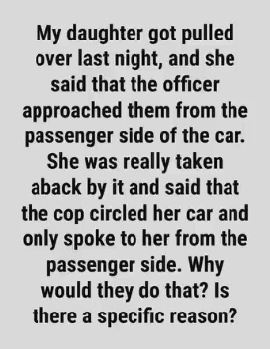
Seeing flashing lights in your rearview mirror can make anyone’s heart race, but traffic stops follow a well-established routine designed to keep both drivers and officers safe. Before pulling anyone over, officers usually run the vehicle’s license plate to confirm registration and ensure it isn’t reported stolen. They also notify dispatch and wait for a safe, well-lit area with manageable traffic before initiating the stop. If it takes you a moment to pull over, that’s perfectly normal — both you and the officer are looking for a secure location.
Once you’re stopped, notice how the patrol car is parked slightly off-center behind you. That angle isn’t random — it creates a protective space, shielding both vehicles from passing traffic. Some officers even turn their wheels outward as an extra safety measure. As they approach, you may see them briefly touch the rear of your car. This small gesture serves two purposes: it confirms the vehicle hasn’t been tampered with and leaves a fingerprint for documentation, linking the officer to that specific car for accountability and safety.
When the officer reaches your window, you’ll typically be asked to turn off the engine and provide your license, registration, and proof of insurance. Expect a few clarifying questions — it’s part of assessing the situation. If passengers are present, the officer may exchange a few words with them too, all in the name of awareness and safety. Keeping your hands visible, following directions, and staying calm helps the encounter remain efficient and professional.
Most traffic stops follow this predictable rhythm from start to finish. The flashing lights are a call for caution, not necessarily punishment. Understanding what’s happening — and why — can ease anxiety and promote trust. For most drivers, the experience lasts only a few minutes, ending with returned documents, a warning, or a citation. When both sides lead with respect and awareness, the road remains safer for everyone.